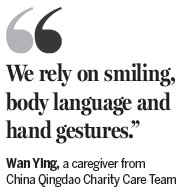
Sumesh Dwivedi jumped for his life from the second floor of his rented house when he felt the earth move suddenly on April 25. He ended up in a hospital.
More than three weeks have passed since the magnitude-7.9 earthquake hit Nepal, leaving more than 8,600 people dead and more than 101,000 others injured.
Dwivedi, 25, is still receiving treatment at a spinal injury rehabilitation center.
In the days after he was injured, the career diplomat thought he would live with the condition for the rest of his life. He even considered suicide.
"I could not feel my lower limbs, but after massage therapy, feeling returned. I can feel them again now," Dwivedi said minutes before Guo Shenggang, head of the China Qingdao Charity Care Team, gave him another routine massage.
The seven-member team arrived in Nepal on Saturday - the third group of Chinese aid workers sent there by the China Charity Federation Long-Term Care Professional Committee.
"We started working as soon as we arrived, taking care of the 93 patients assigned to us," Guo said, adding that this is the first time the group has been on an overseas humanitarian mission.
Guo added that the team members were selected from 120 candidates, including three doctors, three senior caregivers and an interpreter.

The rehabilitation center, located just outside the Kathmandu Valley, is surrounded by green hills and crop fields, and dotted with disaster relief tents from China and other countries.
For Guo's team, life in Nepal is not easy. Since arriving, all seven members have been living in mini-tents they brought from China. Instant noodles are their daily diet, and only one bottle of purified drinking water is provided to each member every day.
"The center is fully occupied by patients, so we have no choice but to live in our tents," said Guo, a surgeon.
Wan Ying, a senior caregiver, said they have had to deal with various kinds of challenges.
"Because we can't speak the patients' language, we rely on smiling, body language and hand gestures to communicate with them," she said. "For example, before washing our patients' feet, we would pat our own feet and ask if it was OK."
Indra Prasad Rajlawat, a middle-aged man who injured his spine in the quake, used a cell phone interpretation software to "talk" with the Chinese aid workers.
Using the software every day, he greeted the Chinese with ni hao (hello) and expressed his gratitude with xiexie (thank you).
"I will travel to China or India for further treatment," Dwivedi said.
(China Daily 05/21/2015 page5)
